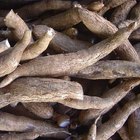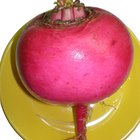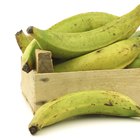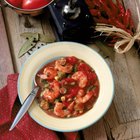
Artlite/iStock/Getty Images
Although the names sound similar, celery stalks and celery root or celeriac are very different vegetables. Because they come from the same species of plant, the tastes are similar, but the physical properties vary significantly between celery stalks and root. You can substitute celery stalks for celery root in some dishes for a milder flavor and lighter texture.
Botanical Difference
Both celery stalks and root are cultivars of the same species of plant, Apium graveolens. A cultivar is a variety of plant selected for certain characteristic that can be passed on through successive generations. The celery plant is composed of above-ground stalks with angular leaves, a round top root below ground and a long taproot diving deep into the soil. Celery is a cultivar that favors the growth of the stalk, whereas celery root favors the growth of the top root.
Preparing Celery Root
The surface of celery root is thick and covered with knobby roots. Peel with a knife as a vegetable peeler will be ineffective. Celery root has a grassy aroma and a texture similar to a potato or turnip. The large root is often cut into cubes, matchsticks or mashed before adding to dishes. Celery root is more dense that potatoes and will need to cook longer to become tender.
Celery Root in Food
Celery root can be eaten raw or cooked. Matchsticks of celery root are often added as a garnish to salads in France. Mashed celery root is often added to soups to add a creamy texture and more complex flavor than a stock made from celery stalk. Celery root can be cubed and roasted in the oven for a different take on oven-roasted potatoes. The thin and tubular stalks from celery root can also be used in a bloody mary cocktail.
Substitutes for Celery Root
Chopped celery stalk may be substituted for celery root to add a milder flavor to the dish. A mix of diced celery stalk and a cubed potato can convey similar flavors and physical characteristics to a dish, such as a soup. Parsley plants have a long taproot that can add a similar but more robust flavor to a dish.
Related Articles

How to Cook Yucca Root

Can You Eat Celery Root Without Cooking ...

How to Mince Celery

How to Roast Turnips
How to Roast Celery

How to Juice a Daikon Radish

How to Boil Celery

How to Make Chicken Vegetable Soup

How to Cook Wax Turnips

How to Garnish a Soup

How to Make Wasabi
How to Shred Daikon

How to Cook Matoke (Plantains) the ...

Differences in Acorn & Butternut Squash

How to Make a Cascading Orchid Bridal ...

Difference Between Gumbo and Etouffee
Can You Eat Chicory Raw?
Can I Freeze Cubed Root Vegetables?

What Is Yellow Zucchini?

How to Cook Frozen Cassava
References
Writer Bio
Chris Daniels covers advances in nutrition and fitness online. Daniels has numerous certifications and degrees covering human health, nutritional requirements and sports performance. An avid cyclist, weightlifter and swimmer, Daniels has experienced the journey of fitness in the role of both an athlete and coach.
Photo Credits
Artlite/iStock/Getty Images